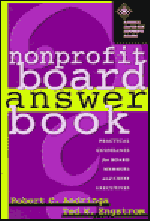 (Reprinted with permission from the CharityChannel's online book review forum, written by Michael Wyland.)
(Reprinted with permission from the CharityChannel's online book review forum, written by Michael Wyland.)
The Nonprofit Board Answer Book, published by the National Center for Nonprofit Boards, is a must-have book for nonprofit senior staffs as well as for volunteer board members who aspire to leadership and stewardship of the organizations they serve. Its authors, Robert C. Andringa, Theodore Wilhelm Engstrom, and Ted W. Engstrom, possess wide experience as chief executives, board members, and facilitators in the training of more than 20,000 board members in twenty countries, according to the publisher.
The book comprises thirty-seven short chapters (typically three to six pages each) in five sections, designed to address all aspects of board service and board-staff issues. Each chapter provides facts, opinions, tools, and a few suggested action steps to help a board address the issue or situation presented in the chapter.
In general, the authors recommend John Carver as a good resource for the theory and practice of nonprofit governance, but they don’t limit the field to Carver as some adherents do. They admit the possibility that other techniques and structures can work well for certain organizations, while sticking to their guns in presenting their experiences and insights as having inherent value for most nonprofits.
I was especially impressed by the distinction made between the role of the board and the role of board members. Many policy governance disputes stem from a misunderstanding that, somehow, all board members should have the same responsibilities and be treated interchangeably.
I would have liked to see a clearer treatment of the issue of board diversity; interestingly, the authors seem to agree, admitting that “it’s a very difficult subject to address.” Many board programs focus on narrowly defined diversity and run the danger of leading to tokenism, according to the authors.
The charts and checklists that supplement the text are simple and effective. They’re easy for readers to re-create and use in their own organizations.
The book even admits to the possibility that nonprofits can (and sometimes should) dissolve and disband, and provides strategies for helping board, staff, and community understand, accept, and even support the natural cycle of life as it applies to organizations. It’s an important message and not a negative one.
Reprinted with permission from the CharityChannel’s online book review forum.